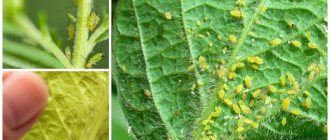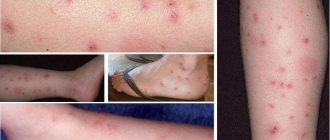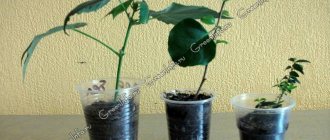A pest called whitefly affects houseplants: impatiens, begonias, geraniums, gerberas and gloxinias. Orchids, fuchsias, indoor pomegranates and dwarf tomatoes suffer from insects.
These parasites, once they have settled in pots, are difficult to remove. A wide range of means are used: from mechanical removal of larvae to biological and chemical insecticides. Traditional medicine also helps - garlic medicine, tobacco infusion, soap solution. But the most important part of treatment is identifying the causes and timely prevention of infection.
Whitefly: what kind of insect is it?
The whitefly, or aleurodidae, is an almost invisible parasite that destroys garden plants. The insect loves indoor flowers, tomato seedlings, peppers, cucumbers, and eggplants. The parasite is especially common in greenhouse conditions. Succulent foliage is eaten by individuals at all stages of life development. To get rid of a butterfly, you need to apply a whole range of preventive measures and use special means for treating summer cottages.
Types and classification of pests
There are about 1,500 species of whiteflies in the world, which differ in habitat and food preferences. In greenhouse conditions, the parasite can constantly multiply, move, and transmit viral and fungal diseases. Eating the lower part of the stems and foliage leads to wilting of plants. Gradual damage to vegetable beds can significantly reduce yields.
Description of the main varieties of whiteflies found in temperate climates:
- Tobacco and cotton. The insect settles on various crops: turnips, beets, cabbage, indoor flowers, outdoor plants, tomatoes, potatoes.
- Greenhouse. It lives in the soil of greenhouses and greenhouses, where the climate is always temperate. Found on indoor plants in warm apartments. This whitefly feeds on vegetable or ornamental crops.
- Citrus. It feeds on tangerine, lemon, orange or lime leaves. In Russia it is found in greenhouses or in the south of Crimea and the Caucasus.
- Cabbage. It settles on cabbage, namely, eats the leaves of the crop at the end of August.
- Strawberry. The whitefly eats strawberry foliage, reduces yield, and harms the fruits of the plant.
Cabbage and strawberry whiteflies are not particularly dangerous for the garden. The insect produces only one offspring during the entire season, and you can get rid of the butterfly invasion by simply washing off the parasite with water. In apartments, aleurodids feed on fuchsia, begonia, orchid, geranium, balsam, passionflower or lantana. They can migrate to neighboring plants.
Habitat and suitable conditions for existence
Whiteflies love warmth and high humidity. Therefore, the parasite can develop year-round in greenhouses, with 3-4 generations present in one area at once. In a garden or greenhouse, the parasite begins to appear en masse in July, when there is intense heat (over 30°C). When the temperature drops below 10°C, adults and larvae die, but eggs laid in the soil are able to overwinter.
This is interesting! You can meet whiteflies in home mini-greenhouses, which are organized on window sills. The insect infects seedlings and then moves to indoor flowers.
Appearance
The whitefly looks like a small moth or white butterfly. The length of the body reaches 2-3 mm. The wings of the pest are covered with a waxy coating, which protects it from the action of chemicals. The parasite larvae are located on the inside of the leaf, on the lower stems of the crop. First instar worms have an oval shape, antennae, and 6 legs. A couple of days after birth, the parasite settles in one place and looks like a microscopic whitish scale. When you shake the affected plant, you may notice a small cloud of small adults.
Life cycle of a whitefly
A female can mate up to 10 times in a month of life. The life cycle of a parasitic butterfly includes many stages, which complicates the fight against insects. The easiest time to get rid of the pest is when the “vagrant” larvae just appear and become vulnerable in search of juicy leaves.
Stages of whitefly maturation:
- the adult female lays eggs;
- after 14 days, first-instar whitefly larvae emerge from the clutch and can search for a suitable habitat for a long time;
- second instar larvae stop at the most succulent areas and become covered with a waxy coating;
- larvae of 3-4 instars, or nymphs, fully feed, but do not yet have the ability to move.
The cycle ends after the adult (imago) begins to move to neighboring plants and beds. Mating of a female with a male occurs 12-20 hours after departure. It is best to kill the insect at this stage, before it has time to lay eggs. The second instar larvae cannot be processed mechanically and are resistant to chemical sprays.
Reproduction and distribution
One individual in just a month of life is capable of laying up to 250 eggs, or 15-20 at a time. After 40 days, adult butterflies develop from the hatched whitefly larvae, which can migrate to other crops and move throughout the greenhouse or garden plot with the help of the wind. The maximum abundance of the pest occurs in July-August, when hot and rainy weather prevails. With the onset of cold weather, the insect dies, but the eggs remain overwintering in the soil to begin their life cycle again in June.
Biological features of the harmful butterfly
Initially, the whitefly lived only in countries with mild and warm climates.
But gradually she adapted to life in cold areas. However, warmth and high humidity are the best conditions for it. Biologists have counted about two hundred varieties of harmful flies. They are omnivores and attack any crop. They especially “love” to live in greenhouses and apartments, but if this is not possible, they feel great even on the weeds in the garden. The size of the butterfly with a white body and transparent wings is small. Males reach a length of 2.5 mm, females - 1.3 mm. The body of the moth is covered with whitish waxy pollen, for which, in fact, it got its name. The pest is a sucking parasite that takes juices from plants. In addition, the butterfly spreads many phytopathogenic viruses. It lives on the inside of leaves, so it is difficult to notice.
Each female lays about 300 eggs per month. They hatch very quickly into gray larvae. They are independent, can move around and look for a place where they can feed. Having found such an area, the larva attaches to the plant and creates a wax cocoon around itself. In this state, it is invulnerable to chemicals. After two weeks, the larva turns into an adult and continues to explore new territories.
Signs of insects
You can notice the infection of plants at the initial stage by carefully examining the lower leaves and stems. If small white butterflies appear when shaking the bushes, the whitefly larvae have already caused serious damage to the plant. It is urgent to begin fighting the insect using chemicals, remove infected leaves and bushes from the garden bed, and poison the soil.
The main symptoms that indicate plant damage by the whitefly butterfly:
- the appearance of translucent scales on the reverse side of the leaf;
- whitish sticky coating (honeydew) on the leaves;
- slower plant growth, lack of fertility;
- the appearance of dark spots.
Whitefly traces, or honeydew, are produced by larvae. These secretions can tighten the leaves of the plant, not giving it enough light and moisture. As a result, flower and vegetable crops begin to wither, the leaves curl, turn yellow, dry out, and fall off. The sweetish coating also attracts ants, which can settle in the greenhouse and bring aphids to the plant.
Insecticides for greenhouse parasites
This method is used only as a last resort, when other methods have failed. The chemical stays in the plant body for more than 30 days - it is prohibited to eat processed vegetables during this time, so this option is not welcome.
The most effective drugs for whiteflies:
Aktara is a multi-component composition that can protect plants for about 5 weeks. To ensure that the parasites die after the first use, the concentration of the solution is 3 times greater than what is written on the package. All vegetables are irrigated at the root. You can make a solution as in the instructions. Moisturizing and spraying will have to be repeated 3-4 times with weekly breaks.
- Teppeki - contains flonicamid, destroys many types of parasites. Remains effective for up to 30 days. Kills whiteflies almost instantly and does not cause tolerance.
- Confidor is a very effective drug, it kills insects in one shot and is sold in ampoules. The result is noticeable after 1.5-2 hours - the parasites die en masse. The active ingredient here is imidacloprid. Analogues containing the same substance: Marathon, Gaucho, Commander, Kopfidor, Provado, Admir.
Match - eliminates adult whiteflies, their larvae, eggs. Valid for up to 3 weeks after treatment. Plants are thoroughly sprayed, which allows you to destroy pests in one go. Spark is the most effective, according to most gardeners. Produced in the form of tablets and sticks. The solution is watered on all the vegetables in the greenhouse - the whitefly dies, but the harmful components of the preparations are found in the leaves, fruits, roots, and soil for about a month. Tanrek - affects the nerve impulses of the parasite, retains properties on leaves for up to 1 month, in soil - more than 180 days, does not affect fruits. Repeated use, if necessary, is carried out after 20 days. When processing, it should be taken into account that the solution is also harmful to bees.
The most popular among gardeners:
- Fitoverm is a contact-intestinal drug that is effective for up to 3 days. The insect dies from eating plants or getting the composition on its body - paralysis occurs. It is recommended to mix it with soap solution. The product is harmless to others, but is expensive, and its effectiveness is below average.
- Actellik is a very effective weapon. Parasites die in 3-4 days. The drug is very toxic; it is not advisable to do more than 4 treatments per season. For use in greenhouses, personal protective equipment should be used.
- Aploud is a drug from Japan that works for about a month. Best used in the morning. Evaporating, it gives an additional effect; it does not affect the fruit.
- Biotlin - kills both adult pests and their eggs and larvae. The liquid depresses the digestive system of the moth - it cannot feed. When using, protect your skin and respiratory organs.
Benzyl benzoate is used as an unconventional remedy. The emulsion is bought at the pharmacy, the ratio is liter of water per 50 ml of the drug. Plants should be treated immediately. Sometimes the fumigator Trunchfluthrin is used - flying individuals are destroyed within 1-2 days, but it does not affect the larvae and eggs, so the treatment is repeated every other day until the entire population is completely destroyed.
Main causes of pest infestation
To prevent crop diseases, you should know where whiteflies come from in greenhouses and on indoor plants. There may be parasite eggs in the soil. Therefore, when planting plants, it is necessary to carefully treat the soil, even if it is purchased. The following conditions also provoke the appearance of butterflies:
- frequent watering of the plant;
- high humidity and temperature more than 30°C in the greenhouse, rainy hot summer;
- close planting of crops to each other;
- lack of ventilation in greenhouses, greenhouses, apartments.
A pest can enter an apartment through open windows and doors. Therefore, it is recommended to regularly inspect the leaves of indoor plants and wipe them with disinfectants. Also, do not place flowers too close to each other.
Preventive measures
To avoid introducing these harmful insects into your home, you should take some precautions.
- The brought soil can be disinfected - pour boiling water on it, steam it in the microwave or oven, and treat it with strong potassium permanganate. This will help destroy eggs and larvae if present.
- New plants must be placed separately , “quarantined”, to exclude the possibility of infection of other flowers.
- important to constantly ventilate the rooms in which indoor plants are located , giving access to fresh air.
- Regularly conduct a visual inspection of existing flowers in order to detect infection in the early stages and react immediately, without waiting for active reproduction of insects.
These simple steps can save your plants from death.
What harm is caused?
Honeydew, which the whitefly leaves on the leaves, provokes the appearance of sooty fungus. It clogs the pores of the plant, which is why the crop gradually dies from lack of oxygen and sun. The spores spread in the wind and remain in the soil. Therefore, a small butterfly can cause crop destruction in the entire greenhouse. Infected plants are removed from the site and burned.
Whitefly is a carrier of the following diseases: leaf curl virus, golden mosaic, infectious yellowing of fruits and crop stems. When the first symptoms appear, treatment is useless; it is necessary to urgently get rid of the affected plants.
Read more about how to effectively get rid of butterfly pests in your garden and vegetable garden in the article here.
We prepare safe products with our own hands
The preparation of products according to folk recipes has already been discussed, so we need to focus on mechanical methods. Making a Glue Trap:
- Paint the pieces of plastic yellow. After drying, cover with entomological glue. Attach the lighting, hang the trap at the level of the tops of the plants.
In 1 hour, up to 80–85% of whiteflies will stick to this structure. At night, you can set another trap: place a light bulb painted yellow in a box, make holes at its level, and immerse a container of water in the bottom.
Means to combat butterflies and their larvae
It is not easy to eliminate the pest from the beds, but if you use an integrated approach, it will be possible to defeat several generations of whiteflies at once. Chemical treatment of soil and plants against parasites should take place before planting seedlings and before the start of the vegetative stage. Folk recipes, mechanical methods and biological products are allowed to be used throughout the spring-summer season. In enclosed spaces, special fumigators deal with the butterfly.
10 ways to get rid of whitefly butterflies forever
Glue traps
To combat adult individuals, sticky traps are used. When flying from plants or beds, most whiteflies fall into placed traps. You can buy them in gardening stores, use regular sticky fly strips. You can make a trap yourself from cardboard or plastic, smeared with rosin, honey, Vaseline, or entomological glue. The parasite is also attracted to light from a light bulb, which burns their thin wings.
This is interesting! Homemade traps should be made on sheets, plywood, yellow or blue plastic. It is these shades that are attractive to insects.
Chemicals
Chemicals help get rid of whiteflies quickly and protect plants for another 4-8 weeks. Insecticides enter the insect's body and intestines (intestinal-contact effects), causing complete paralysis and death from exhaustion within 2-3 days. It is not recommended to treat vegetable crops with toxins after flowering and the appearance of ovaries. Chemicals can also poison the population of beneficial insects: ladybugs, bees, wasps, lacewings.
“Fitoverm”
The safest insecticide that will remove whiteflies will not harm the health of humans, animals, or other beneficial insects. It is recommended to spray the soil, foliage, and inflorescences of plants. To exterminate all pests, 2 treatments with a break of 7 days are enough. The composition is effective for 3 weeks, becoming less effective after rains. An analogue of the product is “Match”, “Aplaud”.
“Aktara”
A universal chemical preparation allows you to immediately poison whiteflies, aphids, midges, and leaf beetles. The toxin from the soil is absorbed into the foliage and stems of plants and remains active for about 5 weeks. If you need to kill large concentrations of pests, you can make a concentrated solution. To do this, a bag of Aktara is diluted in 3 liters of water, instead of 10 liters. This dose will kill all butterflies and larvae, but the seedlings will not be harmed.
"Spark"
“Golden Spark”, “Iskra – double effect”, “Bio-Iskra” are sold in the form of sticks, tablets, ampoules, which are used according to the instructions. The chemical preparation will save the crop from whiteflies and aphids after just one spraying. An irrigated bush contains toxins for up to 30 days, during which time the entire pest population dies.
You should not re-treat plants with the same preparation. The insect will be able to adapt to the toxic composition.
Folk recipes
The fight against whiteflies at home begins with the use of folk methods. Recipes based on herbal decoctions, infusions, household chemicals, and improvised means allow you to get rid of many pests. The natural composition of solutions for spraying beds does not accumulate in the soil, promotes better productivity, does not harm beneficial insects, and does not burn seedlings.
Soapy water
The soap solution washes off the protective wax film from the insect, paralyzes it, and causes death within 2-3 days. To prepare the product, you need to take a bar of laundry or tar soap, grate it and dilute it in 6-7 liters of water. You can spray the bushes with a spray bottle or manually wash each leaf with a foam sponge.
Garlic infusion
The tincture is used to treat indoor plants. To prepare it, just pour 2 chopped cloves of garlic with boiling water and place in a dark and cool place for a day. After infusion, the product is filtered and poured into a spray bottle. To kill the entire whitefly population, treatment is carried out every week for a month.
Infusion of yarrow herb
You can get rid of whiteflies using yarrow juice. To prepare the infusion, take several bushes, chop it finely, knead it with your hands, and pour 4 liters of boiling water. The product is infused for 2 days, then filtered and diluted with another 4 liters of water. For better adhesion of the composition, it is recommended to add about 30-40 ml of liquid soap or shampoo before processing the beds. The medicinal plant can be replaced with celandine.
Tobacco infusion
Tobacco can be used to control small infestations of whiteflies. You need to buy 1 pack of cheap cigarettes, take out the contents, pour 1 liter of boiling water. To infuse, the mixture is sent to a dark and cool place for 5 days. After the strained product, spray the affected plants every 3 days.
Dandelion decoction
To prepare the product, take juicy dandelion bushes (along with roots), chop them finely, pour in 1 liter of boiling water, and then leave the mixture on low heat for 15 minutes. To make the tincture, the herbal decoction is sent to a dark place for 4 days. If it is necessary to treat greenhouses, greenhouses or garden beds, the serving volumes increase 10 times.
Ammonia
The pungent smell of ammonia repels small pests, fertilizes the soil, and helps enhance the growth and flowering of indoor plants. 2 tbsp is enough for a bucket of water. l. ammonia, 30 ml of liquid soap. Treatment is carried out after 18.00 or in cloudy weather, so as not to burn the tender leaves of the seedlings under the scorching sun.
On a note! You can replace ammonia with vinegar. Its smell is also harmful to insects.
Ash
Wood ash helps save beds from whiteflies, fleas, and aphids. It is sprinkled on the soil under the plants, treated between rows or irrigated with a solution on the foliage. You need 1 tbsp. ash, pour 5 liters of water, boil over low heat for about 15 minutes. Afterwards, the broth is cooled and the beds are irrigated with a broom.
Sugar tincture
Sugar infusion is suitable for preventing the appearance of whiteflies on plants. Plants that were in the same greenhouse or nearby with affected crops are treated with a safe product. To prepare the solution, take 200 g of sugar, 1 liter of warm water, mix the ingredients and spray the leaves.
In order for the plant to receive sufficient oxygen and light, 5-6 days after treatment, the sugar solution must be washed off from the leaves.
Mechanical methods
Control whiteflies in small areas manually. It is enough to inspect each leaf of the plant from the inside several times a week. If larvae and butterflies are found, they are shaken off, killed, and washed off with soapy water. Regular watering with a hose is also recommended to force pests down to the ground.
Biological measures
Biological insecticides act in the same way as chemicals, but have a more natural, safe composition. The treatment can be carried out after the formation of the ovaries, does not make the fruits toxic, and the fumes do not harm humans and animals. The most effective product, Verticillin G, contains spores of a fungus that is dangerous to insects. After poisons enter the intestines, the whitefly begins to get sick, infects other individuals and dies after 8-10 days.
Biological measures also include introducing beneficial insects into the beds that feed on whiteflies. Encrasia is a parasitic parasite that lays its eggs in butterflies. It can also suck juice from immobile larvae. Ladybugs and macrolophus bugs love to eat the parasite. To attract predators, dill, marigolds, and daisies are planted around the perimeter of the site.
Fumigators
In greenhouses, conservatories and apartments, you can use a fumigator against mosquitoes and flies. They are placed around the perimeter at an equal distance from each other, windows and doors are closed. While the device is active, you must leave the premises and take your pets. Toxic fumes are effective on butterflies and larvae, but are not harmful to eggs. Therefore, after a few weeks the procedure is repeated.
Prevention Tips
To prevent infection of indoor flowers by parasitic insects, the following preventive measures are recommended:
- avoiding stagnation of water in trays under pots after watering;
- placing plants at a distance from each other to avoid increased crowding;
- quarantine up to 7 days for each new flower;
- regularly ridding bushes of dead branches, dried leaves and inflorescences;
- keeping the plant under regular ventilation conditions;
- using only tested or thoroughly sterilized soil;
- shower days - regularly wipe the leaves and wash them under running cool water;
- use of growth stimulants and fertilizers.
The health of ornamental plants depends on how much the owner takes care of them. Correct growing conditions, attentive attention to the slightest changes in condition, properly applied fertilizing - all this is the key to the health of flowers.
It is important to prevent the appearance of whiteflies in time than to fight parasites with folk or industrial means.
5/5 — (1 vote)
Terms and rules for processing plants
Treatment should be carried out at least 3 times per season. The soil is irrigated with chemicals for the first time in May-June, then a few weeks after planting the seedlings, the procedure is repeated. The last spraying will be in July. If large concentrations of pests are noticed at the dacha, you need to immediately begin treating the plants using traditional methods. Soap solutions and herbal decoctions can be used every week until the whitefly completely disappears.
Treatment of plants with chemicals should take place in an open area or in a ventilated area. For protection, wear gloves, thick clothing, and a respirator. After spraying poisons, you cannot work in the beds for several days, since an invisible poisonous cloud still remains above them. After the formation of ovaries, chemicals are contraindicated. The harvest is not harvested until several months after the plants are irrigated with toxins.
Treatment of plants against whiteflies should occur in calm, cloudy weather. If it rains after spraying with natural remedies, repeat the procedure again. 30-40 ml of liquid soap is added to any solution, which ensures better attachment of the composition to the leaves.
Mechanical method
The whitefly is washed away with a strong stream of water. After this, you need to prepare a soap solution, 100 g of laundry soap per 0.6 liters of warm water. Using a sponge, you need to wipe each leaf with this solution, washing off all the larvae. Many gardeners use tar soap to repel insects with a specific smell.
This method is suitable for small greenhouses. For larger areas the effect of this method will be minimal.
Alternative Methods
Instead of insecticides, practically harmless folk recipes are often used:
- sugar syrup;
- a solution of garlic or tobacco;
- tincture of dandelion or yarrow.
To prepare a potion from yarrow, take 90 g of the dried plant, add 1 liter of water, and leave for 2-3 days. The leaves are sprayed with a spray bottle and wiped with a sponge dipped in the mixture. Tansy planted in the corners of the greenhouse also helps a lot. Interesting! An amazing plant - perennial garden yarrow.
Garlic tincture is made as follows: 160 g of the grated component is poured into 1 liter of water, left for 4-5 days. The resulting solution is diluted to 5 percent, and the vegetables are sprayed. It is very effective if there are not very many insects. You can also take 50 g of dandelion rhizomes, 50 g of its leaves, add a liter of water, leave for a week. Greenhouse plants are treated with the product twice, with an interval of 7-10 days.
For small spaces, any tablets or anti-moth preparations are suitable - each vegetable is supplied with them. Whiteflies tolerate the smell of lavender extremely poorly. Sometimes “cat” shampoo with permethrin is diluted in half and sprayed on plants. It should be remembered that shag infusion is not suitable for combating the tobacco variety of insect.











